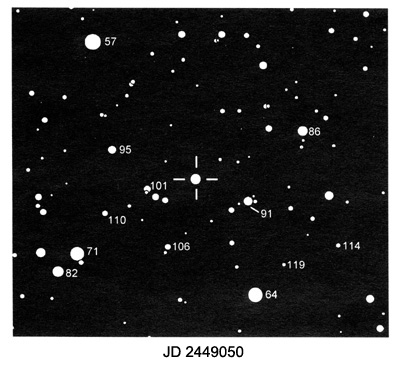Look at the simulated reproduction of a star field below. It contains a variable star that is located in the middle of a set of crosshairs, and surrounding the variable star are several comparison stars of known magnitudes. These stars, which do not vary in brightness, are used to compare the changing brightness, or magnitude, of the variable star. Knowing the values of the magnitudes of the comparison stars, you can estimate the magnitude of the variable star as it changes over time. On a star chart, different magnitudes are portrayed as different sizes - the brighter the magnitude the larger the size of the star, and the dimmer the magnitude the smaller the size of the star. Magnitudes have one decimal, such as 6.3 - however in star fields, the decimals are not indicated. A magnitude of 6.3 is written as 63 so that the fields are not as cluttered and the decimal points are not mistaken for stars. When you record your magnitude estimation you need to include the decimal.
Print out the table provided. Estimate the magnitude of the variable star on the first picture of the star field using the magnitudes of the stars around it. Proceed through each of the pictures and place your estimated magnitudes and the corresponding Julian Day (JD) numbers in the table.



